
Invisalign® Clear Braces – Torrington, CT
Nearly Invisible Orthodontic Treatment

Interested in straightening your teeth? Contrary to popular belief, you do not need metal braces to accomplish this goal! Invisalign® clear braces are a tried-and-true, FDA-approved orthodontic system that uses a series of clear, customized aligners to gradually reposition the teeth. By using three-dimensional computer imaging, a patient’s entire treatment plan can be precisely mapped out before it even begins, ensuring success. On this page, you can learn more about Invisalign® and how it may benefit you.
Why Choose Torrington Dental Care for Invisalign® Clear Braces?
- Subtle appearance that no one is likely to notice
- Custom-made to ensure a comfortable fit
- Often able to straighten teeth faster than traditional braces
How Does Invisalign® Work?

We will provide you with a series of custom-made tooth aligners. You will wear each aligner for 20 – 22 hours each day for about two weeks. The aligners will apply gentle pressure to your teeth and move them little by little. After you work your way through all of the aligners, your teeth should be in their correct positions. You will visit out office for periodic checkups throughout your Invisalign® journey.
Who Can Invisalign Help?
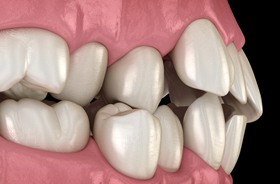
Invisalign is able to address most types of dental misalignment. Whether you want to straighten your teeth for purely cosmetic reasons, or you are aiming to improve your oral health, Invisalign might be ideal for you. Of course, you will need to attend a consultation to find out for sure whether this treatment is a fit for your situation. In the meantime, you can learn about some specific orthodontic issues that it is often used to address by reading the information below.
Crowded Teeth
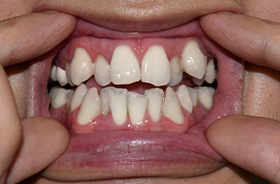
Teeth that are too close together are both unsightly and dangerous to your oral health. They can trap food between them, greatly increasing your risk of dental decay, gum disease, bad breath, and more. Invisalign, along with possible extractions, may be able to alleviate crowding and give you more attractive, more functional teeth.
Gaps Between Teeth
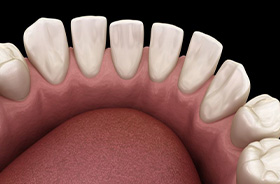
Large gaps between your teeth may be the result of genetics, poor bone development, or other factors. This issue could make you feel self-conscious about the appearance of your smile. The extra space can also leave your gums vulnerable to irritation and damage. Invisalign may be able to gradually move your teeth closer together, resulting in a more confident, more comfortable grin.
Overbite
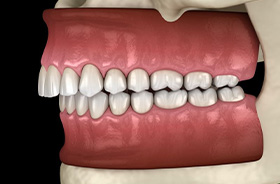
A small overbite is both normal and healthy. However, if your top teeth rest too far in front of your bottom teeth, it can interfere with your oral function and increase your risk of numerous problems, including uneven dental wear, jaw pain, speech issues, and more. Invisalign, usually with the help of special accessories, is often able to address cases of overbite.
Underbite
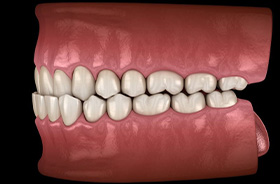
If your bottom teeth rest in front of your top teeth, you have what is known as an underbite. This issue may be caused by genetics, oral trauma, or prolonged thumb-sucking during childhood. Without treatment, an underbite can contribute to sleep disordered breathing, difficulty chewing, and aesthetic concerns. Fortunately, Invisalign and appropriate accessories can correct many instances of underbite.
Crossbite
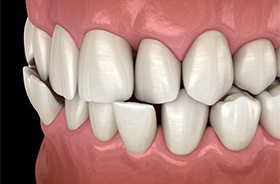
If some of your bottom teeth normally rest in front of your top teeth, you have a form of malocclusion (bad bite) known as a crossbite. This problem may be caused by genetics, poor habits, or the early loss of baby teeth. Invisalign can often correct a crossbite, leading to improved oral function and aesthetics.
Open Bite
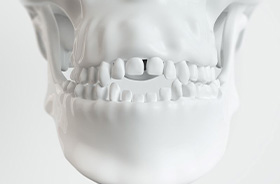
If there is space between your upper and lower teeth even when your back teeth are touching, you have an open bite. This issue, which may be caused by poor bone development or non-nutritive habits during childhood, can interfere with your ability to bite and chew comfortably. In many cases, Invisalign offers a long-term solution to an open bite.
Benefits of Invisalign®
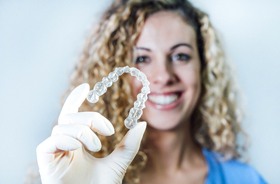
When you commit to Invisalign®, you can expect to receive numerous benefits, including:
- There are no wires or brackets to irritate the soft tissues in your mouth or cause other inconveniences
- Invisalign®’s aligners are made out of patented SmartTrack material, which is designed for comfort and precise treatment
- The aligners are 100% removable, which means no food or drink items are off-limits throughout treatment
- Because the aligners are removable, it will be easy for you to keep your teeth clean throughout your treatment period
- The aligners are very subtle in appearance – most people you pass in a day will not even notice them
- In many cases, Invisalign® is able to straighten teeth much faster than traditional metal braces
- If you ever accidentally lose an aligner or break one, our team is ready to leap into action to help you figure out your next steps
- Invisalign® is much safer and more effective than mail-order tooth aligners
Living with Invisalign Aligners

Invisalign is designed for comfort and convenience. You can expect an easy experience throughout your treatment! Of course, you will still have to make some minor adjustments to your normal routine. Living with Invisalign aligners requires that you pay extra attention to your oral hygiene habits and other activities that could have a bearing on your treatment. Continue reading below to learn about a few aspects of what you can expect during your time with Invisalign.
Wearing Your Trays

You should strive to wear your aligner trays for a minimum of 20 – 22 hours each day. Failure to meet your daily wear time could slow down your tooth movements and make your next set of aligners quite uncomfortable. In fact, you should only take your aligners out of your mouth when you are eating or taking care of necessary oral hygiene tasks.
You will transition to a new set of aligners every 1 – 2 weeks or so.
Cleaning Your Aligners
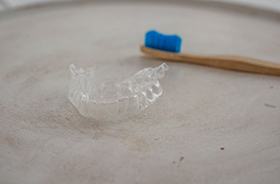
Keeping your aligners clean protects your oral health and keeps your Invisalign fresh and attractive. To clean them, use a soft toothbrush, lukewarm or cool water, and a mild cleaning agent, such as clear hand soap. (Do not use hot water because it might warp your aligners.) You should also make sure to thoroughly brush and floss your teeth so your aligners do not trap food particles and bacteria against your enamel.
Eating & Drinking

No foods are off-limits with Invisalign, but you should still make reasonable, mindful choices about what you eat. Your diet should support your oral and overall health! Remember that it is important to remove your aligners whenever you eat or drink anything other than plain water. Failure to do so could damage your Invisalign, causing it to become warped or stained. While you are eating, you should store your aligners in a protective case to shield them against dust and other environmental factors.
Losing or Damaging a Tray

Accidents happen. You might find that, at some point during your treatment, you accidentally misplace an aligner or damage one so it is no longer usable. If that happens, call our dental team. We might advise you to go back to wearing a previous aligner while we order a replacement for the one you can no longer use. Alternatively, we might give you the go ahead to move on to your next aligner a bit earlier than originally planned.
Routine Check-Ins

We will schedule you for routine Invisalign checkups every 4 – 8 weeks. During these brief appointments, which often last just 15 minutes or so, we will check on your progress, provide you with the next set of aligners in your series, and answer any questions that you may have. At some point during your treatment, we may need to make adjustments to the overall plan for moving your teeth; these appointments can take a bit longer.
Understanding the Cost of Invisalign

When you visit Torrington Dental Care for your Invisalign consultation, he will evaluate your dental misalignment and map out your treatment plan. Then, our team will be able to give you an accurate estimate for the cost of your treatment. In some cases, dental insurance is willing to cover at least a portion of the cost of Invisalign. We can also help you to apply for low-interest financing through a third-party company if necessary.
Factors that Affect the Cost of Invisalign
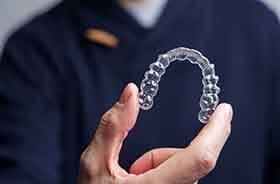
The biggest factor that influences the cost of Invisalign is the number of aligners that will be necessary to complete your case. This can be affected by:
- The severity and complexity of your dental misalignment.
- Whether you are straightening one dental arch or both.
- The total proposed treatment time.
- Your compliance with treatment instructions. (If you accidentally lose or damage an aligner, you may need to pay to replace it.)
The need for additional accessories can also affect the cost of Invisalign. For example, some patients require special attachments to correct bite problems.
Invisalign vs. Mail-Order Aligners: Which Costs More?
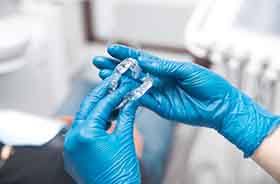
Invisalign can cost at least a few thousand dollars, so many people are tempted to turn to lower-cost alternatives, such as mail-order clear aligner systems. Often, these treatments cost around $2,000. Admittedly, that low price can be very tempting!
Of course, cost is not the only thing that you should think about when you are weighing your treatment options. It is also important to consider value. With Invisalign, you get a proven system that uses top-tier technology, materials, and techniques. Results are consistently positive! You also get the in-person support of a dental team that truly wants to see your treatment succeed.
Mail-order aligner systems tend to be less reliable. Mistakes and missteps are more likely when you do not have in-person care. Some patients have even inadvertently worsened the condition of their teeth while using mail-order clear aligners.
It is best to play it safe and invest in high-quality, in-person care right from the beginning of your orthodontic treatment journey.
Does Dental Insurance Cover Invisalign?

Some premium dental insurance plans include orthodontic coverage for adults. Often, Invisalign is eligible for coverage. Your plan might cover up to 50% of your treatment, up to the amount of your plan’s lifetime orthodontic maximum. Many patients are able to save hundreds of dollars out-of-pocket by using their insurance. Our team welcomes more than 200 dental plans, and we will be happy to help you figure out how your benefits may apply.
Options for Making Invisalign Affordable

Outside of insurance, there are a few provisions that could make it easier to afford Invisalign:
- Most patients qualify for a low-interest payment plan through a third-party financing company. The application process is fast and easy!
- Special offers. We periodically have special offers on Invisalign treatment to help patients save money.
- Essential Dental plan. This discount plan provides reduced fees on most of the services available in our office.
Are you eager to learn more about Invisalign and its cost? Our team would be pleased to answer your questions! Get in touch with us today to request a consultation.
Invisalign FAQs
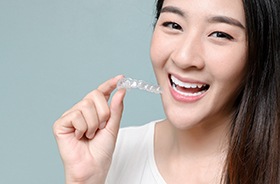
As your general and cosmetic dentist in Torrington, our team is ready to help you take advantage of Invisalign®. However, we completely understand if you would like more information before you commit to a consultation. Below, you will find answers to some frequently asked questions about this treatment. If you do not see your specific questions addressed, feel free to give us a call — our team will be happy to speak with you!
How Long Does Invisalign® Take?
The average treatment time with Invisalign® in Torrington is 12 months. However, your case may require more or less time. It depends on factors like the extent of your dental misalignment, how many aligners you require, and how well you comply with treatment instructions. During your consultation, we will be able to estimate how long Invisalign® will take to straighten your teeth. For the majority of patients, Invisalign® is a faster option than traditional metal braces.
Does Invisalign® Hurt?
Invisalign® aligner trays are made out of a smooth plastic, which is designed to rest comfortably against the gums and other soft tissues in the mouth. There are no metal brackets and wires to irritate sensitive areas like the cheeks and tongue.
However, it is important to keep in mind that orthodontic treatment can be successful only if it applies adequate pressure to the teeth. Naturally, this process can cause some discomfort, particularly when you first switch to a new aligner. You can make your treatment as easy as possible if you switch aligners at night (so you can sleep through the first part of the adjustment period). Sipping on cold water and taking painkillers may also be helpful.
What Happens After Invisalign®?
After you have finished wearing all of your aligners, we will verify that the results are what we hoped for. Then, we will provide you with a retainer. There are a few different types of retainers, but they all serve the same purpose; they prevent the teeth from drifting back out of place following orthodontic treatment. If you have a removable retainer, you must wear it full-time at first (20 – 22 hours each day). After a few months, however, we may give you the go-ahead to wear it only at night. You should not underestimate the importance of using your retainer as recommended; it could ultimately determine the success or failure of your Invisalign® treatment.
What if My Invisalign® Broke?
Invisalign® aligners are generally quite durable. However, accidents can happen that cause them to incur damage. If your aligner has small hairline cracks, you might be able to continue wearing it — just be extra careful when you are putting it in your mouth and taking it out. If the damage is more severe, do not try to wear the aligner, and do not try to repair it on your own. Instead, give our office a call. We might advise you to switch to a new aligner a few days early. It is also possible that we will tell you to go back to wearing your previous aligner until we can order a replacement for the one that is no longer usable.